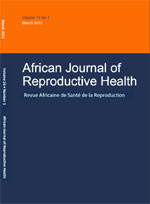
|
African Journal of Reproductive Health
Women's Health and Action Research Centre
ISSN: 1118-4841
Vol. 18, No. 3, 2014, pp. 87-94
|
 Bioline Code: rh14046
Bioline Code: rh14046
Full paper language: English
Document type: Research Article
Document available free of charge
|
|
|
African Journal of Reproductive Health, Vol. 18, No. 3, 2014, pp. 87-94
| fr |
Mucunguzi, Stephen; Wamani, Henry; Lochoro, Peter & Tylleskar, Thorkild
Résumé
La réduction de la mortalité maternelle n'a pas été appréciable dans la plupart des pays à faible revenu. L’amélioration de l'accès aux transports pour les mères est une façon d'améliorer la santé maternelle. Cette étude a évalué l’intervention des services gratuits d’ambulance et des communications assurés pour 24 heures dans le district d'Oyam à l’aide de « taux d’opération césarienne» (TOC) et nous l’avons comparé avec le quartier voisin de non-intervention. Les données écologiques ont été recueillies rétrospectivement à partir des dossiers de maternité / théâtre en octobre 2010 au cours de trois ans avant et pendant la période d'intervention de 3 ans. Le TOC moyen dans le district d'intervention a augmenté de 0,57% avant l'intervention à 1,21% (p = 0,022) au cours de l'intervention, alors qu'il n'y avait pas de changement dans le district voisin (0,51% à 0,58%, p = 0,512). L’accouchement à l'hôpital a augmenté de plus de 50% par an, avec une légère diminution dans les mortinaissances en milieu hospitalier pour 1000 naissances dans le district d'intervention (de 46,6 à 37,5, p = 0,253). Les services de communication et de transport fiables ont augmenté l'accès aux, et à l'utilisation des services de santé maternelle, notamment les services d’accouchement par voie césarienne.
Mots Clés
césarienne; soins obstétricaux d'urgence; services ambulanciers; accessibilité; orientation et le système de communication
|
| |
| en |
Effects of Improved Access to Transportation on Emergency obstetric Care Outcomes in Uganda
Mucunguzi, Stephen; Wamani, Henry; Lochoro, Peter & Tylleskar, Thorkild
Abstract
Reduction in maternal mortality has not been appreciable in most low-income countries. Improved access to transport for mothers is one way to improve maternal health. This study evaluated a free-of-charge 24-hour ambulance and communication services intervention in Oyam district using ‘Caesarean section rate’ (CSR) and compared with the neighbouring non-intervention district. Ecological data were collected retrospectively from maternity/theatre registers in October 2010 for 3 years pre and 3 years intervention period. The average CSR in the intervention district increased from 0.57% before the intervention to 1.21% (p=0.022) during the intervention, while there was no change in the neighbouring district (0.51% to 0.58%, p=0.512). Hospital deliveries increased by over 50% per year with a slight reduction in the average hospital stillbirths per 1000 hospital births in the intervention district (46.6 to 37.5, p=0.253). Reliable communication and transport services increased access to and utilization of maternal health services, particularly caesarean delivery services.
Keywords
caesarean section; emergency obstetric care; ambulance services; accessibility; referral and communication system
|
| |
© Copyright 2014 - African Journal of Reproductive Health
Alternative site location: http://www.ajrh.info
|
|
